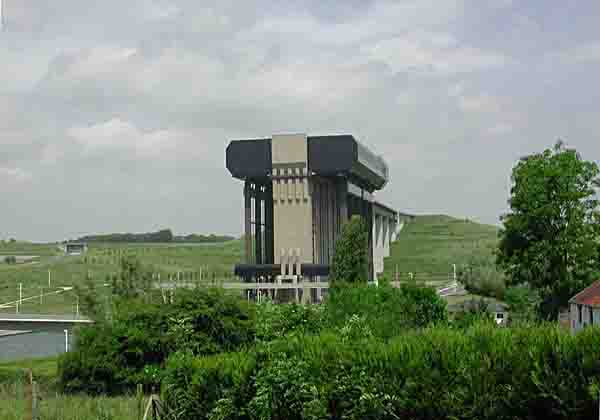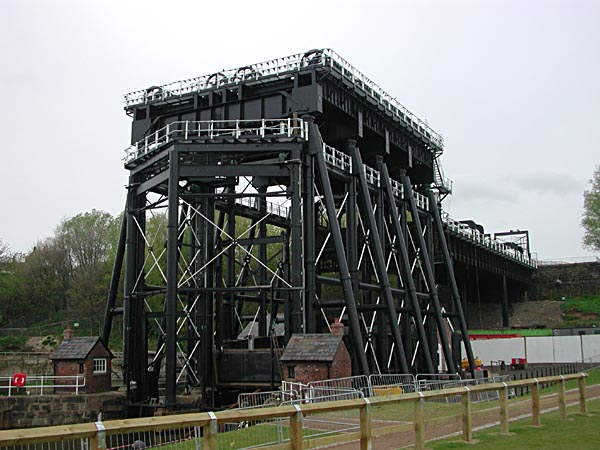CANAL BOAT LIFTS
The first evidence of boats being lifted vertically from one canal level to another appears at Halsbrücke in Germany in 1789. It included a five purchase block and tackle arrangement to dry lift 3ton boats on the Halsbrücke canal about 7m and it must have been hard work! It was in operation till 1868. However, in 1766 Erasmus Darwin (Charles Darwin's Great Grandfather) had described a 'lock for navigation' in his Commonplace Book of inventions. It used a more sophisticated arrangement to reduce the energy required whereby the boats were to be floated into chambers called caissons each filled with an equal amount of water. Darwin's sketches show the caissons linked together with either levers or chains passing over large wheels to achieve a perfectly balanced mechanism.
 |
 |
 |
Because the boats displaced their own weight of water the system remained perfectly balanced so, for example, a loaded boat could be easily raised as an empty boat descended. The only energy input required was that to overcome the friction of the machinery. This balance principle forms the basis of all the successful canal lifts built after 1830, the first being those of the Grand Western Canal in Somerset (1832 to 1867) Today a new lift at Strépy-Thieu in Belgium [see below] is designed to raise 1350 ton barges 73m in one go. This lift actually uses a caisson and a counter balance rather than two caissons.

The Falkirk Wheel in Scotland [see below] uses two caissons supported by rotating beams. Both used the same balance principle.
 Around 1800 a number of experimental lifts were built in the UK. Some worked but were never considered reliable enough to be brought into full commercial operation and were dismantled. Of particular note was, first, ironmaster Fussell's experimental "Balance lock for raising or lowering boats" built in 1800 at Mells in Somerset on a branch of the proposed Dorset and Somerset Canal. It was reported to have been successful but as the canal was never completed it did not have a chance to prove itself and second, the Anderton Lift [see next image] near Northwich in Cheshire, the first hydraulic lift.
Around 1800 a number of experimental lifts were built in the UK. Some worked but were never considered reliable enough to be brought into full commercial operation and were dismantled. Of particular note was, first, ironmaster Fussell's experimental "Balance lock for raising or lowering boats" built in 1800 at Mells in Somerset on a branch of the proposed Dorset and Somerset Canal. It was reported to have been successful but as the canal was never completed it did not have a chance to prove itself and second, the Anderton Lift [see next image] near Northwich in Cheshire, the first hydraulic lift.
As lifts got bigger more power was required to overcome friction so hydraulic and later, electrical systems, were introduced to give greater flexibility of control. Anderton has recently been restored and is in use linking the Trent and Mersey Canal and the Weaver Navigation

